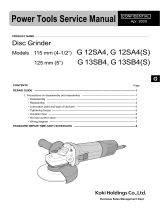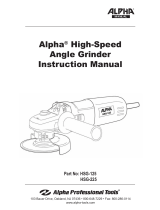
--- 7 ---
(2) Never press the pushing button while the depressed center wheel is rotating.
If the pushing button is pressed while the depressed center wheel is rotating, the spindle will stop immediately.
In such a case, there is a danger that the wheel nut may be loosened so that the depressed center wheel flies
off unexpectedly to cause possible serious injury.
7-4. Operation Phenomena to Be Noted in Sales Promotion
(1) The overload protection circuit tends to be easily actuated by certain types of work. If excessive pressure is
applied on the tool during cutting or similar heavy-duty operation, the overload protection circuit will be
actuated and the motor will be automatically stopped. This is because the overload protection circuit detects
the increased flow of current caused by the excessive pressure on the tool, and automatically turns off the
motor to protect it from possible overload burnout. The customer should be advised that the Models G 13YD
and G 13V are specifically designed to perform more efficiently and faster with considerably less applied
pressure than is required for conventional disc grinders, and that skillful use of the tools with minimal applied
pressure will avoid actuating the overload protection circuit.
(2) The customer should be advised to immediately remove the tool from the workpiece when the overload
protection circuit has been actuated, and not to resume operation until the tool has again reached normal
rotation speed. In this case, it takes slightly longer for the tool to reach normal rotation speed than at the time
of soft start (about three seconds). If the user attempts to resume operation before the tool has reached
normal rotation speed, the overload protection circuit will immediately reactuate.
(3) When beginning operation, if the Depressed-Center Wheel or cut-off wheel is pressed against the workpiece
before the tool has reached full rotation speed, there is a chance that the overload protection circuit will be
actuated. Instruct the customer never to turn the switch on with the Depressed-Center Wheel in contact with
the workpiece, or to press the wheel against the workpiece immediately after the switch has been turned on.
(It is strongly recommended that operation be begun only after a constant, normal rotation speed has been
attained).
(4) Failure of the control circuit may result in abnormally high rotation speed. If the control circuit in the tool
should malfunction, the rotation speed may increase excessively, and continued use of the tool would be
extremely hazardous. In such a case (when rotation speed increases abnormally), the operator will become
aware of abnormal noise from the motor and/or gears. Should such a phenomenon occur, the customer is
advised to immediately shut off the tool, and bring it to the nearest Hitachi authorized sales outlet or repair
center for inspection and repair.
(5) There may be minor variation in the operation of the overload protection circuit. Although the tool is designed
to minimize variation of the operation of the overload protection circuit, there may nonetheless be some
variation caused by fluctuation in the power supply or ambient temperature. Accordingly, the following points
should be noted:
a. When the ambient temperature is low, the point (current load ) at which the overload protection circuit
activates will be higher.
b. After several minutes of operation, when the main body of the tool becomes warm, the overload protection
circuit will activate at a load current approximately 15% lower than immediately after starting operation.






















